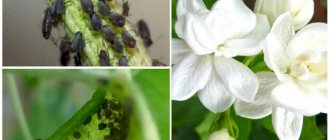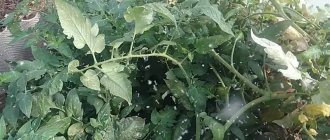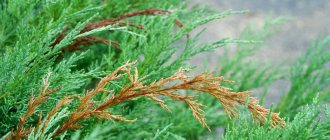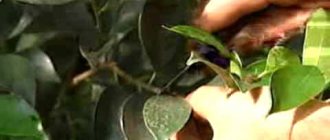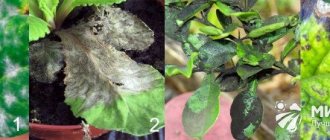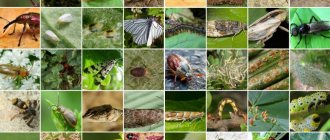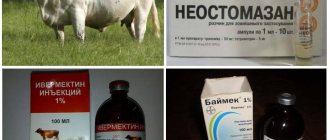If you carefully read our article about caring for Balsam, most likely your pet will not get sick. But it’s not always possible to take perfect care of your flower, because summer has come - it’s time for vacations. What should you do if you were away from home for a long time, and upon arrival you discovered that your Balsam was sick? Read the next article, in which we will talk about how to deal with diseases and pests of indoor Balsam.
Common ailments, their treatment and photos
Gray rot
This is a fungal disease. It is characterized by the appearance of brown spots on stems and leaves. If measures are not taken in time, the flower will die.
Causes:
- hypothermia;
- watering with cold water;
- drafts;
- low air temperature;
- soil contamination with spores of pathogenic fungi.
Treatment:
- The affected parts of the plant are cut off with a sterile instrument to healthy tissue.
- The healthy part is sprayed with Fundazol from a spray bottle. Fundazol is a systemic fungicide with a broad spectrum of action. Preparation of the solution: dilute 1 g of powder with 1 liter of water, stir until completely dissolved. Spraying is carried out carefully; all above-ground parts of the plant must be treated.
- The indoor flower is transplanted into a pot with new soil. Before planting, the soil is also sprayed with a solution of Fundazol. The drug is diluted in the same proportion. Once in the soil, the fungicide prevents the development of pathogenic fungi.
Before the procedure, the instrument (scissors or pruning shears) should be kept in medical alcohol, and the sections should be sprinkled with charcoal powder or cinnamon.
Bacteriosis
It appears as watery spots that quickly enlarge and acquire a brown tint.
Causes:
- contaminated soil;
- dirty tools;
- excess moisture or fertilizer.
Treatment:
- Pruning diseased parts of the plant.
- Spraying with copper oxychloride (CHOM). This is a fungicidal preparation with protective contact action. The solution is prepared in the following proportion: 4 g of powder per 10 liters of water. Then carefully spray the plant from all sides with a spray bottle.
- After 14 days, the procedure is repeated.
- The soil should also be sprayed with the same solution.
Powdery mildew
The disease is characterized by the appearance of a white coating on all parts of the plant, curling and drying of the leaves (read about why balsam leaves can hurt here, and about why leaves can turn yellow, read here).
Causes:
- improper watering;
- air stagnation;
- low temperature;
- bad light.
Treatment:
- Removing diseased parts of the plant.
- Spraying with soda ash solution. To do this, dissolve 1 tablespoon of soda in 5 liters of water, add 2 tablespoons of liquid soap. Thoroughly spray the plant with this solution using a spray bottle.
- The procedure is repeated after 10 days.
- As an alternative, you can use a copper-soap solution. To do this: 5 g of copper sulfate is dissolved in 250 ml of hot water. Separately prepare a soap solution: 50g of soap is grated and dissolved in 5 liters of warm water. Then a solution with vitriol is poured into it. The plant is sprayed with this emulsion from a spray bottle.
Mosaic disease
It is characterized by the appearance of spots on the leaves, followed by their drying out and falling off. Flowers and buds also fall off.
The disease is viral in origin and is fatal to balsam. The mosaic virus is spread by thrips (parasitic insects) and cannot be treated.
The diseased plant should be destroyed and the soil should be thrown out of the pot.
You will find a list of the main diseases of balsam in our material.
Impatiens pests
Spider mite
Signs of spider mites are yellow specks on the surface of the leaves. If left untreated, these specks will later develop into large spots that will be discolored and dry.
Spider mites are small insects that live on the inner surface of leaves.
Typically, the appearance of spider mites is caused by dry air and elevated indoor temperatures. Therefore, for prevention, constantly spray the plant with water.
To avoid the spread of the pest, the affected parts of the flower must be removed. If the lesions are still mild, you can wash the leaves with soapy water or mineral oil.
If the disease is already quite severe, the leaves must be treated with “Fitoverm”, “Akarin”, “Vertimek”, “zipper” or other drugs.
Whitefly
A whitefly is a small insect, two to three millimeters in size with white wings; the insect larvae are also white and they cause the most harm.
The disease can be noticed by the yellowing of the leaves and the presence of specific sticky secretions on them; insects can also be seen on the inside and outside of the leaves.
To resist whitefly, the leaves are treated with special means, based on potassium soap or other preparations: “Aktellik”, “spark”, “biotlin”, “tanrek”, “bison”, “karbofos”, “inta-vir” and others.
Multi-clawed mites
Multi-clawed mites are small transparent white insects, about a third of a millimeter in size.
Symptoms of multi-clawed mites include hardening and distortion of leaves. They practically do not grow and begin to curl at the edges.
The cause of multi-clawed mites is increased temperature and humidity in the room.
To prevent mites, you need to check the plant regularly.
If the balsam is already infected, use such drugs to treat it as: “Fitoverm”, “Molniya”, “Vertimek”, “Akarin”.
Trips
Signs of this disease are deformation of young leaves, since their growing point is bent under the influence of thrips. Also signs of their appearance are the appearance of spots on flowers and browning of the petals along the edges.
Thrips actively appear in the area of flower stamens and are carriers of bronze leaves.
In order to combat thrips, it is necessary to immediately remove infected leaves and flowers. You should especially carefully monitor young plants, since even short-term contact with pests can cause them to be permanently damaged.
It is necessary to treat the flower against thrips with such preparations as “actara”, “fufanon”, “actellik”, “spark”, “tanarek” and others.
It is necessary to use special preparations in a course of several procedures with a difference of 4-5 days, since insecticides may not act during all periods of insect development.
If the plant dries out
First of all, you should inspect it for the presence of spider mites. If the parasite is present, then this is the cause.
What should be done:
- Trim flowers to reduce strain.
- Lather the sponge with laundry soap and wipe the plant. You should also wipe the pot and tray.
- Rinse the soap thoroughly with running water from the shower.
- After drying, spray the plant with Fitoverim (an insectoacaricide with enteric contact action). To prepare the solution, you need to dissolve 5 g of the drug in 1 liter of water. Spray the flower with a spray bottle. Repeat the procedure after 10 days.
Spider mites are parasites that feed on plant cell sap. As a result, they become weak and susceptible to infections.
If there are no spider mites, then the reasons may be the following:
. In order to solve the problem, you need to spray the flower twice a day.
Dry air- Air temperature . It should not fall below 15 degrees.
- Direct sunlight . First, burns appear, and then the flower dries up.
- Soil quality . If the soil has not been changed for more than a year, it becomes depleted. The flower lacks nutrients.
- Root rotting . Reasons: excessive watering, soil contamination with fungal infections.
- Insufficient watering . The plant suffers from lack of moisture.
Causes of flower death:
- Diseases of fungal, viral and bacterial nature.
- Pests. Thrips, whitefly, spider mites, aphids.
- Improper care: excessive watering (causes root rot), insufficient watering, low temperature combined with high humidity.
Biological effects
For every predator there is a worse predator. Thus, the enemy of the spider mite is the phytoseiulus bug. The artificial colonization of plants by these insects makes it possible to destroy the parasite with someone else's teeth, so to speak. Disadvantage: this method can only be used in closed ground conditions.
To combat ticks, biological products have been created: “Akarin”, “Bitoxibacillin”, “Fitoverm”. How to use them correctly?
- "Akarin" is diluted in a proportion of 2 ml of the drug per liter of water.
- “Bitoxibacillin” - 80-100 g per 10 liters of water. The disadvantage of this drug is that it can cause allergies upon contact with treated plants.
Both solutions are used throughout the growing season every 15-17 days.
“Fitoverm” is diluted in an amount of 10 ml per 10 liters of water. Processing is carried out every 7-10 or 14-20 days. The treatment period depends on the age and size of the plant.
The pesticides clofentesine and flufenzine belong to the hormonal group. They do not destroy all individuals at once, but sterilize the uterus. The effect of their use is long-term, but becomes noticeable after a few days. Some individuals die out, while others do not appear. If you need to destroy a tick urgently, you can mix this drug with any of the biological products.
How to reanimate a plant to save it?
What to do if the flower has withered, drooped and darkened at the base and is slowly dying? If the flower dies, urgently do the following:
- Find out the reason.
- Adjust air and soil humidity.
- Trim the affected areas back to healthy tissue.
- Eliminate drafts.
- Avoid exposure to sunlight.
- Spray the flower with fungicide. It is best to use the broad-spectrum drug Discor. To do this, dissolve 1 ml of the drug in 2 liters of water. Spray the plant with the resulting solution from a spray bottle. Repeat procedures after 10–12 days.
Discor is a highly effective chemical fungicide of contact and systemic action. Covers a wide range of diseases. Often used in cases where the plant disease is uncertain.
If the roots are damaged:
- Remove the flower from the pot and carefully free the root from any lumps of soil.
- Rinse the root under running water.
- If there are damaged areas on the root, prune them.
- Prepare a Kornevin solution at the rate of 1 g of powder per 1 liter of water.
- Place the plant there so that only the roots are immersed in the solution.
- After a day, replace the solution with water, place the flower there and leave there until young roots begin to grow.
- After this, the balsam can be transplanted into new soil.
Corevin is a chlorine-free biostimulating drug that promotes the development and restoration of the root system.
Reproduction
Reproduction of wet roly-poly is possible at any time of the year. Cuttings are made below the nodes, removing the lower leaves and the weak top.
Vanya propagates by cuttings. For planting young seedlings, the substrate must be light enough. In order for the plant to take root faster, the bowls are placed in a dark place for a couple of weeks.
Planting is carried out when their length is 5-6 cm in soil fertilized with peat and sand. It is possible to place several roots in one pot at once, so the flowering of the bush will be more luxuriant.
Vanka can be propagated by seeds in the spring by planting 2-3 seeds in a pot, pre-treated with a weak solution of potassium permanganate (1%).
Why do flowers fall?
There may be several reasons why flowers wither and fall off:
- The soil is too wet . This provokes rotting and death of the roots. In this case, the plant does not receive nutrients from the soil and drops flowers.
- Lack of potassium . Potassium is necessary for good flowering; if the soil is poor, the plant does not have enough strength to flower (this article explains why balsam does not bloom).
- Pests often cause flowers to drop. They suck out plant juices and thereby cause various diseases. After which an infection often occurs.
- Incorrect fertilizing , namely excess nitrogen in the soil. Nitrogen promotes crown development and inhibits flowering.
- Anxiety . Impatiens do not like being moved, turned, or transferred from one room to another. This causes stress and causes the colors to drop.
- Transplantation during flowering . This is strictly prohibited, as the plant is subjected to severe stress and stress.
- Inappropriate soil . The soil for balsam should be slightly acidic, light and loose. This is the only way the plant can fully absorb all nutrients. Otherwise, the flower feels uncomfortable.
Peculiarities
The leaves and stems of balsam are very juicy, that is, their cells contain a lot of water and little dry matter. This is well illustrated by a situation where there has been no watering for a long time: leaves and shoots quickly wither, hang like rags, losing their shape. Leaf turgor directly depends on their moisture saturation.
There is the opposite situation: good watering and high humidity lead to the appearance of small droplets of sweet liquid along the edge of the leaf. It is for this ability that the balsam received the name Vanka wet.
Prevention and proper care at home
Rules of care:
- Impatiens loves diffused light and does not tolerate direct sunlight. Therefore, it is better to place the pot on the eastern or western windowsill.
- Balsam loves abundant watering. It needs to be watered regularly and abundantly, otherwise it will wither, but do not allow the soil to become waterlogged.
- The pot must have holes.
- There must be drainage under the layer of soil in the pot (expanded clay, small stones, etc.).
- In winter, watering is reduced. In winter, water balsam 1-2 times a month.
- The air temperature should not fall below 15 degrees.
- From early spring to late autumn, balsam needs regular feeding. The frequency of feeding is once every 3 weeks.
- The plant should be replanted every spring.
Prevention:
- Regular inspection for diseases and pests.
- Proper care. The room should not be warm, light or humid.
- Once every six months, balsam is sprayed with a solution of Fitosporin for preventive purposes. To do this, ½ teaspoon should be dissolved in 2 liters of water. The resulting solution is sprayed onto the plant from a spray bottle.
Care and prevention are the best way to prevent diseases. If you do everything correctly, you will not have to urgently save your pet from death. Use the above tips, and balsam will delight you with its beauty and lush flowering for a long time.
Physical wrestling
This concept means, first of all, the creation of favorable conditions for the development of plants: watering, killing weeds. For indoor plants, temperature is of great importance.
We suggest you read: Fighting yellowing of eggplant seedlings
The first single affected plants must be removed immediately. Destroy torn out damaged leaves or shoots, do not just leave them on the ground - this is a breeding ground for the next generations of the pest.
It would be a good idea to irradiate indoor plants with ultraviolet light: this slows down the reproduction of the parasite.
Parasites: diagnosis, causes and actions
Impatiens are most often affected by mites - these are annoying small parasites that suck all the juice from the stem. Also dangerous to the plant are aphids, thrips and whiteflies.
Tick infestation
Characteristic signs can be noticed when examining the back of the leaf or internodes. Symptoms of spider mite infestation are a thin white film and small dots on the foliage, loss of shine, and a decrease in the intensity of flowering. The reasons for the appearance are high room temperature and low humidity levels. How to deal with spider mites on balsam?
- Trimming affected parts.
- Treating the bush with a soap solution (it is preferable to dilute tar soap in water). Apply foam to the plant, rinse after 5-10 minutes. Repeat the procedure after 7 days.
- With a high degree of infection, treatment with chemicals is required. Their list includes Fitoverm, Vertimek. Select the dosage according to the instructions.
Impatiens can also be parasitized by cyclamen mites. It deforms young leaves, lateral buds and shoots. The plant loses its growth points and quickly dies. You can get rid of the pest only by treating it with acaricides.
The insect sucks the juice from the leaves, then they become deformed and growth stops. With a high degree of damage, the process of photosynthesis is impossible, as a result, balsam stops developing normally and dies.
It is quite difficult to notice an infestation on a bush, but aphid nests made of whitish plaque are clearly visible on the walls of the pot.
Important! The reason for the development is improper care and irregular watering (the pest multiplies in dry soil).
